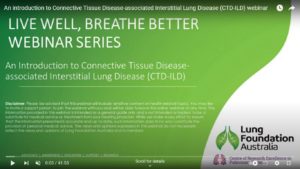In this webinar, Respiratory and Sleep Physician, Dr Adelle Jee, provides an overview of Connective Tissues Disease-associated Interstitial Lung Disease (CTD-ILD) and shares insightful tips to help get the most out of your treatment and care. You will also hear from consumer representative, Tania, who shares her experience of navigating her CTD-ILD diagnosis and management journey.
CTD-ILD is a group of interstitial lung diseases (ILD) caused by connective tissue diseases such as systemic sclerosis, rheumatoid arthritis, and inflammatory myopathies. These diseases affect body parts like joints and skin but can also involve other organs. ILD is characterized by thickening or scarring of lung tissue, and not everyone with connective tissue disease will develop Connective Tissues Disease-associated Interstitial Lung Disease.
Symptoms of CTD-ILD vary widely and can include fatigue, weight loss, fever, breathlessness, persistent dry cough, muscle weakness, joint pain, Raynaud’s phenomenon, skin rashes, fingertip ulcers, dry eyes, and gastrointestinal issues like reflux and swallowing problems.
Diagnosis involves a multidisciplinary approach, including blood tests, high-resolution CT scans, lung function tests, echocardiograms, and possibly bronchoscopy or biopsy. Diagnosis can be challenging and may require multiple visits to healthcare providers.
Treatment options depend on individual circumstances and may include immunosuppressive medications (e.g., prednisolone, mycophenolate) and anti-fibrotic medications (e.g., nintedanib). Non-pharmacological treatments such as pulmonary rehabilitation, oxygen therapy, psychological support, nutrition, and smoking cessation are also important. Treatment aims to stabilise or reverse the disease or slow its progression.
Management of CTD-ILD requires a team approach, involving GPs, respiratory specialists, rheumatologists, cardiologists, pharmacists, physiotherapists, psychologists, and specialist nurses.
Patients are encouraged to maintain a healthy lifestyle including – keep vaccinations up to date, exercise regularly and maintain a healthy diet. It is also important to stay connected with your healthcare team and seek support from family, friends, and support groups.
Was this page helpful?
Good job! Please give your positive feedback
How could we improve this post? Please Help us.
